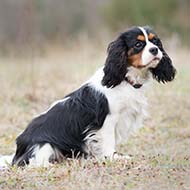Scientists 'step closer' to understanding syringomyelia

Scientists developed a computer model based on the MRI from a Cavalier King Charles Spaniel.
A study led by scientists at the University of Surrey has revealed new insights into the development of spinal cord disease, syringomyelia, revealing that a hypothesis developed by neurosurgeon Bernard Williams in 1980 is likely to be correct.
Syringomyelia is a painful spinal cord disease of dogs and humans characterised by fluid-filled cavities, but it is not yet fully understood exactly how these cavities are formed.
In 1980, neurosurgeon Bernard Williams hypothesised that pressure changes resulting from sneezing and coughing caused fluid in the cavity to “slosh”, thereby placing stress on the spinal cord tissue and enabling the cavity to expand.
In this latest study, researchers from the University of Surrey's Centre for Biomedical Engineering Sciences and the School of Veterinary Medicine developed a computer model based on the MRI from a Cavalier King Charles spaniel with syringomyelia.
Through the model, the scientists were able to show that the fluid “slosh” caused a small cavity to expand gradually down the spinal cord. However, when the syrinx became large, there was less focal stress – a finding that could explain why syringomyelia can develop rapidly but then remain unchanged in shape over time.
Looking ahead, the team plans to develop the model to improve understanding of why syringomyelia develops and to model potential surgeries for reversing the condition. Their findings are published in the journal Life.
“It has been both fascinating and challenging to work on the problem of syringomyelia over the last decade," commented Dr Srdjan Cirovic, a lecturer in biomedical engineering at the University of Surrey. "With this breakthrough, we are one step closer to understanding this puzzling neurological condition.
He added: "In the future, we are looking towards using these findings to inform the improved medical treatment of syringomyelia in humans as well as animals.”



 The RCVS has announced a new version of its 1CPD mobile app, with enhanced features for veterinary surgeons and veterinary nurses to record their continuing professional development.
The RCVS has announced a new version of its 1CPD mobile app, with enhanced features for veterinary surgeons and veterinary nurses to record their continuing professional development.